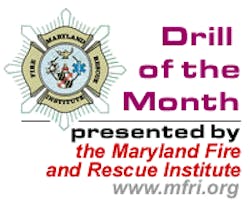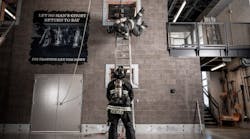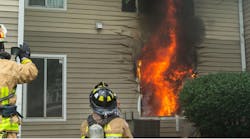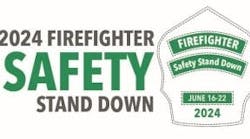Structural Firefighting Review: Fire Attack
Session Reference: 1
Topic: Fire Attack
Level of Instruction: 3.0
Time Required: 3 Hours
Materials:
• Personal Protective Clothing
• Personal Alert Safety System (PASS) Device
• Self-Contained Breathing Apparatus
• Burn Building with fuel
• Two water sources
• One or two class A pumpers (fully equipped)
References:
• Essentials of Fire Fighting, Fourth Edition, IFSTA, Chapter 14
• NFPA 1500 and 1403
• 29 CFR 1910.134
PREPARATION:
Motivation:
Objective (SPO):
The student will demonstrate, working as part of a team, their ability to advance charged hoselines into a structure and attack an interior fire, all done while demonstrating generally accepted safety practices.
Overview:
Fire Attack
• Hoseline operations
• Location of fire
• Fire Attack
• Back up teams
FIRE ATTACK
SPO The student will demonstrate, working as part of a team, their ability to advance charged hoselines into a structure and attack an interior fire, all done while demonstrating generally-accepted safety practices.
EO 1-1 Demonstrate approaching and observing live fire as an exercise in interior structural firefighting (NFPA 1001 (1997) 3-3.9).
EO 1-2 Demonstrate the recognition of smoke, flame, and steam production in a live fire situation (NFPA 1001 (1997) 3-3.9).
EO 1-3 Demonstrate a gaining of confidence in the use of self-contained breathing apparatus in a smoke and heat environment (NFPA 1001 (1997) 3-3.9).
EO 1-4 Demonstrate an understanding of individual physical and emotional limits (NFPA 1001 (1997) 3-3.9).
I. Student Pre-Requisites
A. Verification by the lead instructor of completion of personal protective clothing and positive pressure self-contained breathing apparatus training. This can be done by inspection of a pocket card or verbal verification by the ranking officer of the department present at the class.
B. Certification by the student that they are in good health and physical condition. This can be done by verbal questioning.
C. Full protective clothing including a helmet with ear protection and a suspension system, turnout coat and pants with vapor barrier and protective liner, boots with steel toes and insoles, fire retardant leather gloves, and fire retardant hood. All protective clothing shall be clean and in good condition. Nomex or PBI coats and pants and non-metallic helmets are recommended. Nylon quilted liners in coats or pants or plastic or rubber covered gloves will not be permitted. It is recommended that long pants and long sleeve shirts, both of cotton, be worn under the protective clothing to reduce the possibility of steam burns.
D. Each student will have a positive pressure self-contained breathing apparatus and a personal alert safety system (PASS) in place as part of their protective clothing prior to entering the structure. Both items will be activated at all times while in the structure.
II. Instructional Procedures
A. Brief introduction of all instructors participating in the evolution.
B. Appointment and introduction of the safety officer who shall be responsible for the overall safety of the training activity. This role may be assumed by the lead instructor provided he/she is not participating in the instruction or an officer from one of the departments participating.
C. General briefing of what is being covered and the educational objectives.
D. Walk-through of the structure and pointing out of burn areas and means of egress.
E. General safety precautions including staying out of openings, opening and closing nozzles at the direction of the instructor, hose handling entering and exiting the structure, staying low, staying dry, and accounting for all crew members at all times. The students will also be advised of the general evacuation signal.
F. The instructional cadre should consist of a lead instructor and at least four other instructors. In addition to the instructors, two individuals will be needed to stoke the fires.
G. Prior to entering the structure, each student is to be inspected by the safety officer to insure that all protective clothing and equipment is in place, providing proper protection, and operating properly. The safety officer is also responsible for monitoring the personal accountability system and knowing who is in the building, there SCBA pressure at the time of entry, and how long they have been in the building.
III. Method of Instruction
A. Upon completion of all safety inspections and clearance of the safety officer, the students will enter the structure. One instructor will be positioned at the front of the attack crew and the other instructor will be positioned at the rear of the attack crew.
B. All students will be on the same side of the hose line with the nozzle person and back-up person within arms reach of each other. Other crew members will be positions appropriately to advance the hose line.
C. Students will enter the burn room in a crawling position with the hose line between the students and the fire.
D. All students are to be either in the burn room or outside the room before the instructor authorizes the nozzle to be opened. The nozzle person should account for all crew members before initiating attack.
E. At the conclusion of the attack, all crew members are to position themselves in a manner to reduce body surface area to avoid steam burns.
F. At the direction of the instructor, the person on the nozzle go around will the nozzle and move to the rear of the crew. Other crew members will move forward and assume their new positions on the hose line.
G. The attack process outlined above will resume until every crew member has had an opportunity to operate the nozzle.
H. The crew will then retreat from the building with the nozzle person and back-up person maintaining control of the nozzle in the event of re-ignition. Other crew members will be positioned to assist with hose line removal.
I. Upon exiting the structure, the instructors will conduct a brief review of the activities and check for any injuries. The students should check their air supply and rehydrate prior to re-entry.
J. The instructional process will continue until all students have been rotated through the structure.
K. Before dismissal of the group, all equipment and apparatus must be returned to service and the area must be cleaned.
IV. Method of Firefighting (1-1, 1-2, 1-3, 1-4)
A. The students will be instructed in the proper nozzle pattern and setting for better coverage.
B. Each attack crew will consist of three to five firefighters, with one instructor at the nozzle position and one instructor at the rear of the hose line crew.
C. The nozzle pattern and flow should be checked prior to entering the structure. Upon entering the structure, the nozzle should not be opened until advised by the instructor. The instructor will also advise where the stream is to be directed and the pattern and method of attack to be used.
D. The nozzle should be closed when advised by the instructor.
E. Students will be rotated on the nozzle at the instructor's direction.
F. The "buddy system" will be used while in the structure. Everyone should be watching for everyone else.
G. The crew should all be on the same side of the hose line and properly spaced to permit ease in advancing and retracting the hose.
H. The minimum size hose line permitted for structural firefighting is 1-1/2-inch. No straight tip or smooth bore nozzles are permitted.
I. Two hose lines must be in place and ready for use prior to any individuals entering the structure for firefighting. One hose line will be used by the attack crew. A second hose line will be used by the back-up crew and will be available as a safety line. Prior to a crew entering the structure, a back-up crew of a size similar to the attack crew, and with at least one instructor, will be in place and ready to enter the structure should the need arise. The back-up crew should move up to the attack crew position when the attack crew exits the structure. A new back-up crew should replace the existing one. Consideration should be given to a separate water supply for each line.
J. Only excelsior or untreated straw will be used in the burn building. No more than one-half bale of excelsior or straw is to be used for each crew. All burning in the burn building must be done in the designated areas.
K. The instructors and the firefighting crews should be reminded of the importance of ventilation at part of the activity. Adequate provisions must be made to allow the steam to vent when attacking the fires to prevent steam burns.
L. The class is responsible for cleaning up the burn building and surrounding area. This includes making sure all burned materials are extinguished, placing partially burned material in the proper receptacle, and cleaning out the building.
M. A critique should be conducted at the conclusion of each training activity. This should include a check of the students to insure that no injuries went unreported and that any equipment repairs are reported. The roster must be completed for any activities conducted at the Training Center.
SUMMARY:
Review:
Fire Attack
• Hoseline operations
• Location of fire
• Fire Attack
• Back up teams






